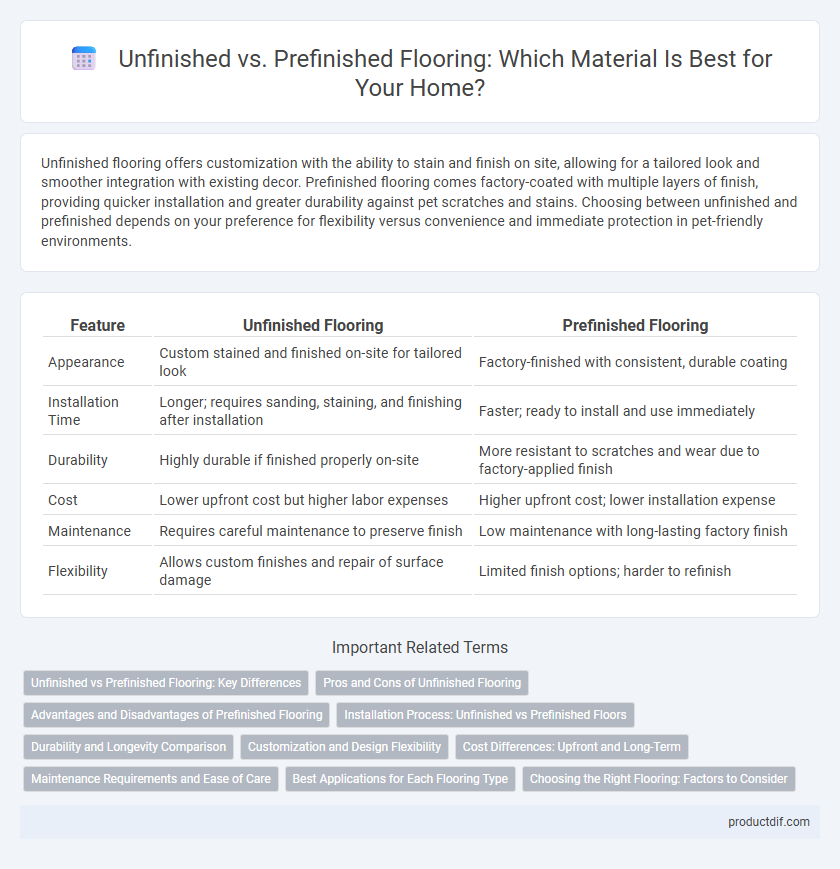Unfinished flooring offers customization with the ability to stain and finish on site, allowing for a tailored look and smoother integration with existing decor. Prefinished flooring comes factory-coated with multiple layers of finish, providing quicker installation and greater durability against pet scratches and stains. Choosing between unfinished and prefinished depends on your preference for flexibility versus convenience and immediate protection in pet-friendly environments.
Table of Comparison
| Feature | Unfinished Flooring | Prefinished Flooring |
|---|---|---|
| Appearance | Custom stained and finished on-site for tailored look | Factory-finished with consistent, durable coating |
| Installation Time | Longer; requires sanding, staining, and finishing after installation | Faster; ready to install and use immediately |
| Durability | Highly durable if finished properly on-site | More resistant to scratches and wear due to factory-applied finish |
| Cost | Lower upfront cost but higher labor expenses | Higher upfront cost; lower installation expense |
| Maintenance | Requires careful maintenance to preserve finish | Low maintenance with long-lasting factory finish |
| Flexibility | Allows custom finishes and repair of surface damage | Limited finish options; harder to refinish |
Unfinished vs Prefinished Flooring: Key Differences
Unfinished flooring requires on-site sanding and finishing, allowing for a fully customized stain and seamless finish tailored to specific room dimensions. Prefinished flooring comes factory-coated with durable, cured finishes, enabling faster installation and reduced exposure to dust and fumes. Unfinished options offer greater flexibility in design and repair, while prefinished floors provide convenience and consistent quality control.
Pros and Cons of Unfinished Flooring
Unfinished flooring offers the advantage of customization, allowing homeowners to select their preferred stain and finish for a unique, tailored look. This flooring type often requires on-site sanding and finishing, which can extend installation time and increase labor costs. Despite the longer installation process, unfinished flooring tends to have superior durability and repairability compared to prefinished options.
Advantages and Disadvantages of Prefinished Flooring
Prefinished flooring offers the advantage of faster installation since it arrives sanded, stained, and sealed, reducing labor time and mess. It provides a more consistent finish with fewer onsite disruptions, making it ideal for quick renovations. However, it has limited ability for refinishing compared to unfinished flooring, and installation requires precise subfloor preparation to avoid damage.
Installation Process: Unfinished vs Prefinished Floors
Unfinished floors require on-site sanding, staining, and sealing after installation, demanding more time and skilled labor, which can extend the overall project timeline. Prefinished floors come factory-sanded and sealed with durable coatings, allowing for faster installation with less mess and minimal downtime. The choice impacts the complexity, labor costs, and installation speed, influencing the overall flooring project efficiency.
Durability and Longevity Comparison
Unfinished hardwood flooring offers superior durability due to its ability to be sanded and refinished multiple times, extending its lifespan for decades. Prefinished flooring features factory-applied coatings that provide immediate protection against wear and tear, though its thinner finish limits the number of refinishing cycles. Choosing unfinished floors maximizes longevity through periodic refinishing, while prefinished floors offer convenience with moderate durability.
Customization and Design Flexibility
Unfinished flooring offers superior customization and design flexibility by allowing homeowners to choose their preferred stain color, finish, and texture after installation. Prefinished flooring provides limited design options as the stain and finish are applied during manufacturing, restricting changes once installed. Opting for unfinished flooring enables tailored aesthetics to match unique interior styles, while prefinished flooring favors convenience over personalization.
Cost Differences: Upfront and Long-Term
Unfinished flooring typically has a lower upfront cost compared to prefinished options, but requires additional expenses for sanding, staining, and finishing after installation. Prefinished flooring offers a higher initial price but reduces labor costs and time due to factory-applied finishes, leading to quicker installation. Over the long term, unfinished floors may incur higher maintenance and refinishing costs, whereas prefinished floors generally provide better durability and lower upkeep expenses.
Maintenance Requirements and Ease of Care
Unfinished flooring requires sealing and finishing after installation, demanding more initial maintenance and periodic refinishing to maintain its appearance. Prefinished flooring arrives with factory-applied coatings that offer enhanced durability and easier cleaning, reducing long-term maintenance efforts. Both types benefit from regular sweeping and avoiding excessive moisture to extend their lifespan.
Best Applications for Each Flooring Type
Unfinished flooring is ideal for custom stain and finish applications, making it perfect for homeowners seeking a tailored look or working with irregular room shapes requiring on-site adjustments. Prefinished flooring suits high-traffic areas and busy households due to its factory-applied, durable finish that ensures faster installation and immediate use. Choosing unfinished flooring benefits renovation projects where matching existing colors is essential, while prefinished options excel in new construction for streamlined installation and consistent appearance.
Choosing the Right Flooring: Factors to Consider
Choosing the right flooring requires evaluating factors such as installation time, maintenance, and budget. Unfinished flooring offers customization through on-site sanding and staining but demands more labor and expertise. Prefinished flooring provides a faster installation with factory-applied finishes that resist wear and reduce upkeep.
Unfinished vs Prefinished Infographic

 productdif.com
productdif.com